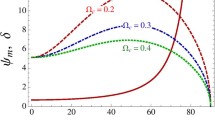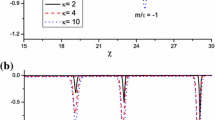Abstract
The problem of arbitrary amplitude electron-acoustic solitary (EAS) waves in a plasma having cold fluid electrons, hot superthermal electrons and stationary ions is addressed. The domain of their allowable Mach numbers enlarges as the spectral index κ increases revealing therefore that the “maxwellisation” process of the hot component favors the propagation of the EAS waves. As the superthermal character of the plasma is increased, the potential pulse amplitude increases while its width is narrowed, i.e, the superthermal effects makes the electron-acoustic solitary structure more spiky. As the spectral index κ decreases, the hot electrons are locally expelled and pushed out of the region of the soliton’s localization. A decrease of the fractional number density of the hot electrons relative to that of the cold ones number density would lead to an increase of the depth as well as the width of the localized EAS wave. Our results should help to understand the salient features of large amplitude localized structures that may occur in the plasma sheet boundary layer and may provide an explanation for the strong spiky waveforms that have been observed in auroral electric fields.
Similar content being viewed by others
References
Alinejad, H.: Astrophys. Space Sci. 325, 209 (2010a)
Alinejad, H.: Astrophys. Space Sci. 327, 131 (2010b)
Aoutou, K., Tribeche, M., Zerguini, T.H.: Phys. Plasmas 15, 013702 (2008)
Aoutou, K., Tribeche, M., Zerguini, T.H.: Phys. Plasmas 16, 083701 (2009)
Baluku, T.K., Hellberg, M.A.: Phys. Plasmas 15, 123705 (2008)
Barghouthi, I.A., Pierrard, V., Barakat, A.R., Lemaire, J.: Astrophys. Space Sci. 277, 427 (2001)
Berthomier, M., Pottelette, R., Malingre, M., Khotyaintsev, Y.: Phys. Plasmas 7, 2987 (2000)
Berthomier, M., Pottelette, R., Muschietti, L., Roth, I., Carlson, C.: Geophys. Res. Lett. 30, 2148 (2003)
Bharuthram, R.: Astrophys. Space Sci. 202, 337 (1993)
Bharuthram, R., Shukla, P.K.: Astrophys. Space Sci. 149, 127 (1988)
Boubakour, N., Tribeche, M., Aoutou, K.: Phys. Scr. 79, 065503 (2009)
Brodsky, Y., Nechuev, S.I., Slutsker, Y.Z., Fraiman, G.M.: Fiz. Plazmy 14, 582 (1988)
Cattaert, T., Verheest, F., Hellberg, M.A.: Phys. Plasmas 12, 042901 (2005)
Ergun, R., Carlson, B., McFadden, M.: Geophys. Res. Lett. 25, 2025 (1998)
Fried, B.D., Gould, R.W.: Phys. Fluids 4, 139 (1961)
Gary, S.P., Tokar, R.L.: Phys. Fluids 28, 2439 (1985)
Gill, T.S., Kaur, H., Bansal, S., Saini, N.S., Bala, P.: Eur. Phys. J. D 41, 151 (2007)
Hellberg, M.A., Mace, R.L., Baluku, T.K., Kourakis, I., Saini, N.S.: Phys. Plasmas 16, 094701 (2009)
Kumar, N., Sikka, H.: Astrophys. Space Sci. 312, 193 (2007)
Lakhina, G.S., Singh, S.V., Kakad, A.P., Verheest, F., Bharuthram, R.: Nonlinear Process. Geophys. 15, 903 (2008a)
Lakhina, G.S., Kakad, A.P., Singh, S.V., Verheest, F.: Phys. Plasmas 15, 062903 (2008b)
Leubner, M.P.: Astrophys. Space Sci. 282, 573 (2002)
Mace, R.L., Hellberg, M.A.: Phys. Plasmas 8, 2649 (2001)
Mace, R.L., Hellberg, M.A.: Phys. Plasmas 16, 072113 (2009)
Mace, R.L., Baboolal, S., Bharuthram, R., Hellberg, M.A.: J. Plasma Phys. 45, 323 (1991)
Mann, G., Classen, H.-T., Motschmann, U., Kunow, H., Dröge, W.: Astrophys. Space Sci. 264, 489 (1998)
Marsch, E., Muhlhauser, K.H., Schwenn, R., Rosenbauer, H., Pillip, W., Neubauer, F.M.: J. Geophys. Res. 87, 52 (1982)
Pakzad, H.R.: Astrophys. Space Sci. 324, 41 (2009b)
Pakzad, H.R.: Astrophys. Space Sci. 323, 345 (2009a)
Pakzad, H.R.: Astrophys. Space Sci. 326, 69 (2010)
Pakzad, H.R., Tribeche, M.: Astrophys. Space Sci. (2010, in press). doi:10.1007/s10509-010-0367-1
Pottelette, R., Berthomier, M.: Nonlinear Process. Geophys. 16, 373 (2009)
Sagdeev, R.Z.: In: Leontovich, M.A. (ed.) Reviews of Plasma Physics, vol. 4, p. 23. Consultants Bureau, New York (1966)
Saini, N.S., Kourakis, I., Hellberg, M.A.: Phys. Plasmas 16, 062903 (2009)
Sarafopoulos, D.V., Sarris, E.T., Angelopoulos, V., Yamamoto, T., Kokubun, S.: Ann Geophys. 15, 1246 (1997)
Scudder, J.D., Sittler, E.C., Bridge, H.S.: J. Geophys. Res. 86, 8157 (1981)
Shizgal, B.D.: Astrophys. Space Sci. 312, 227 (2007)
Singh, S.V., Lakhina, G.S.: Planet. Space Sci. 49, 107 (2001)
Singh, S.V., Lakhina, G.S.: Nonlinear Process. Geophys. 11, 275 (2004)
Tagare, S.G., Singh, S.V., Reddy, R.V., Lakhina, G.S.: Nonlinear Process. Geophys. 11, 215 (2004)
Thorne, R.M., Summers, D.: Phys. Fluids B 3, 2117 (1991)
Tokar, R.L., Gary, S.P.: Geophys. Res. Lett. 11, 1180 (1984)
Tribeche, M., Boubakour, N.: Phys. Plasmas 16, 084502 (2009)
Tribeche, M., Mayout, S., Amour, R.: Phys. Plasmas 16, 043706 (2009)
Verheest, F., Cattaert, T., Hellberg, M.A.: Space Sci. Rev. 121, 299 (2005)
Verheest, F., Hellberg, M.A., Lakhina, G.S.: Astrophys. Space Sci. Trans. 3, 15 (2007)
Watanabe, K., Taniuti, T.: J. Phys. Soc. Jpn. 43, 1819 (1977)
Younsi, S., Tribeche, M.: Phys. Plasmas 15, 073706 (2008)
Author information
Authors and Affiliations
Corresponding author
Rights and permissions
About this article
Cite this article
Younsi, S., Tribeche, M. Arbitrary amplitude electron-acoustic solitary waves in the presence of excess superthermal electrons. Astrophys Space Sci 330, 295–300 (2010). https://doi.org/10.1007/s10509-010-0404-0
Received:
Accepted:
Published:
Issue Date:
DOI: https://doi.org/10.1007/s10509-010-0404-0




